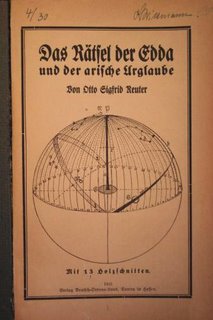Otto Sigfrid Reuter has obtained in recent years the dubious sobriquet of, together with Hermann Wirth, the founding father of Nazi Archaelogy. Reuter (1876 - 1945) was a staunch Ariosophist and founder of several Aryan-Christian orders such as the Deutschglaubige Gemeinschaft and the Germanische Glaubensgemeinschaft, founded in 1911 and 1912 respectively. The aim of these orders was the fusion of blood and religion, hence, membership was restricted to "true Aryans". Some have it that these orders still exist today.
Reuter's reputation rests predominantly on his book Germanische Himmelskunde (German Sky Lore), published in 1934. The idea behind his orders was to rid Christianity of the Jewish influences to make it more digestible for Germans. Reuter's book Sigfrid oder Christus? Ein Kampfruf (Sigfrid or Christ? A Battle Cry), published in 1908, reflects his philosophy. Highly succesful, it was reprinted in 1910.
His next book, Das Ratsel der Edda und der Arische Urglaube (The Riddle of the Edda and the Ancient Religion of the Aryans), published in 1921, 1922 and 1923, was a continuation of his ideas. Reuter believed in the reality of the Edda 'like a maniac' as one authority has it. This was one of the reasons why Reuter left various nationalist and racist German orders which stood at the cradle of National Socialism. It appears that Reuter could not tolerate ideas that were not of his own.
 |
| Otto Sigfrid Reuter on his 60th birthday as published in Mannus, issue 28, 1936, found here. |
Reuter's philosophy was based on the study of the Edda was that the oldest human culture had come from a Germanic North. The idea of a world axis - the Axis Mundi or Irminsul, the column that supports heaven -was invented by the Germans and the names of all the constellations were based on ancient German science that had its origin aeons before our time. He also believed that the divine was to be found within the German race. Reuter died on 5 April 1945 by heart attack. Allied bombs had wrecked his home earlier. With him perished his dreams of a prehistoric Aryan supercivilisation that had encoded its secret wisdom in the stars, in the Gotterdammerung of the Third Reich.
 |
| Das Ratsel der Edda und der Arische Urglaube, 1922, page 48. |
But all
this does not do Reuter’s book justice. Reading the antiquated Fraktur Schrift
is like visiting another world, far removed from the shallow modernity of our times. I
wonder how many of us have read the book; I found no recent scholarly assessment or critical treaty of its
contents. Reuter’s book is full of strange ideas and should be placed in the larger context of ultra-conservative illuminated literature. Reuter’s interpretations of
the ‘Nordic Rock paintings’ (see pages 47-48) can be considered as a forerunner
of the school of ancient astronauts. Reuter writes:
“Opposed to that, examining the rock drawings… we must notice:
1. .. a general bird headedness, that seems to point to their flying nature;
2. their floating composure;
3. their mostly uplifted hands, often extra sized;
4. the connection of these figures with circles, many sliding coils, ships and chariots;
5. the interspersion of the images with numerous single and grouped points, which are replaced in some images with radiant stars;
6. the connection of the figures and companions with these single or grouped together standing points or stars;
7. the absence of house images and earthly needs.
Reuter concludes by writing that ‘it
is not about earthly, but heavenly paintings and representations of gods.’
Radiant stars, godly beings and heavenly chariots as sacred Germanic lore.
Reuter on page 49:
“ The images of the ships. We know from ancient times that the sun and the moon were accosted as ships of the heavens, which sail away on the sea of heaven. The depiction of such ships is not only known to the southern and eastern peoples, but also to the Germans (as Tacitus reports). Even in the Edda one finds an elaborate entry on this…”
 |
| Reuter's 'Germanic Worldview' as depicted in his Das Ratsel der Edda und der Arische Urglaube, 1922, page 87.
I acquired an original edition of
Reuter’s book years ago, but its extremely brittle paper and worn out
leather binding gave me concerns in regards to preserving this unique artefact
of a bygone era. Fortunately since then a digital scan of the book can be downloaded here. More biographical data provided by his daughter Irmgard Teubert, written in 1985, are found here and the text of a letter by SS-Oberscharfuhrer Lasch, asking Reuter for help in selecting a proper teacher of Germanic 'Himmelskunde' for Wewelsburg, dated 14 October 1935 is found here. Reuter's essay 'Der Himmel uber den Germanen' is found, translated and annotated, here.
|









